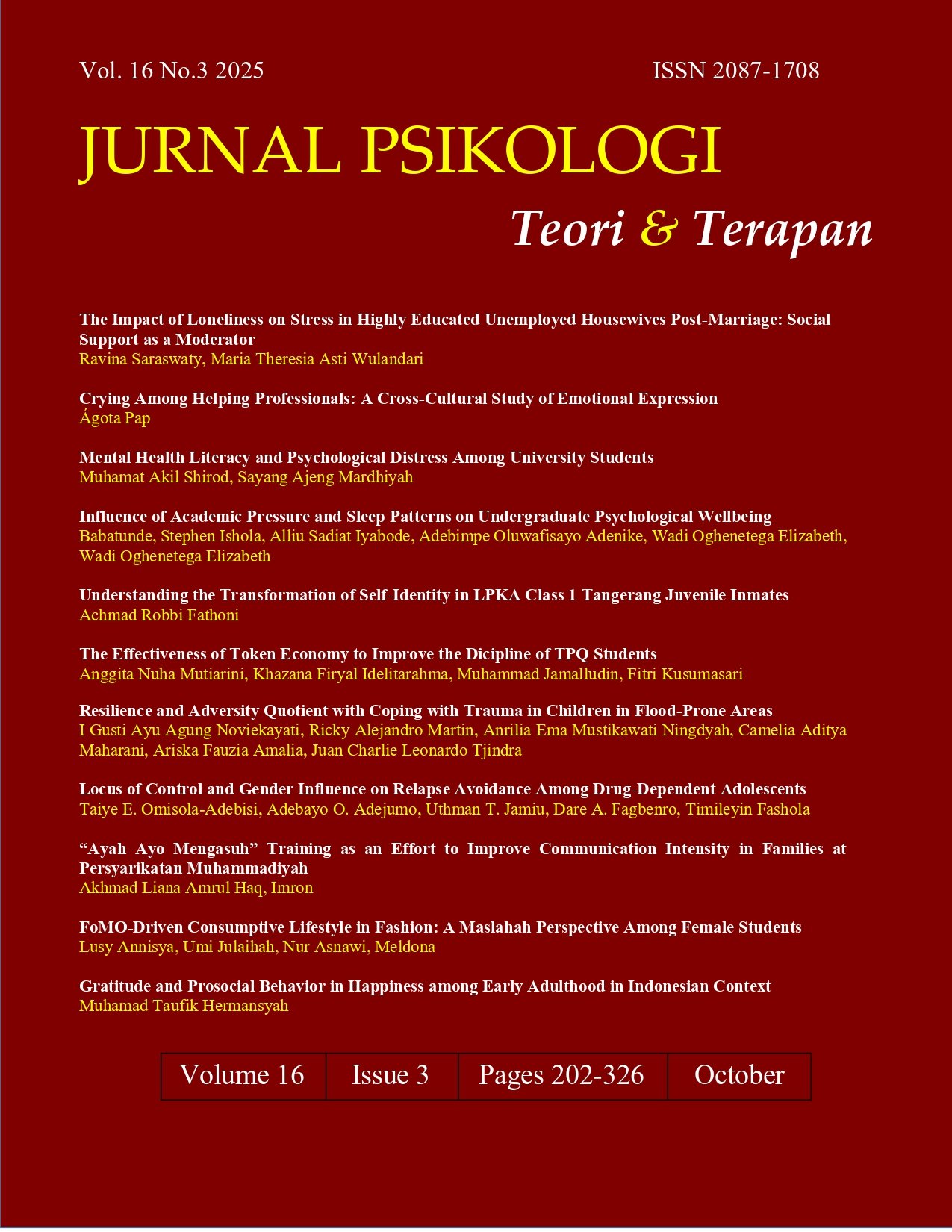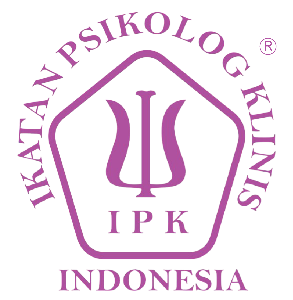Crying Among Helping Professionals: A Cross-Cultural Study of Emotional Expression
DOI:
https://doi.org/10.26740/jptt.v16n03.p217-228Keywords:
crying, helping professional, emotional processing, empathy, cultural differences, self-awareness, resilienceAbstract
Background: Crying is a universal but understudied emotional expression serving intrapersonal and interpersonal functions such as stress regulation, empathy, and social bonding. Although therapist crying in sessions has been explored, little is known about how helping professionals experience and regulate crying beyond therapy. Understanding these patterns is crucial for promoting professional well-being and recognizing culturally shaped emotions. Objective: This study examined the prevalence, contextual factors, and cultural patterns of crying among helping professionals, and its links with self-awareness and life satisfaction. Methods: Ninety Serbian- and Hungarian-speaking therapists from Vojvodina completed the Adult Crying Inventory (ACI), Satisfaction With Life Scale (SWLS), and a demographic questionnaire. Analyses included descriptive statistics, t-tests, correlations, and ANOVA. Results: Women cried more often than men; crying decreased with age and experience. Married individuals showed higher life satisfaction. Hungarians reported crying alone more often and in response to unmet expectations, while Serbians cried more in others’ presence. Conclusion: Crying among helping professionals reflects emotional, demographic, and cultural dynamics, underscoring the need for emotional self-awareness and resilience in professional training.
Abstrak
Latar Belakang: Menangis adalah ekspresi emosional universal namun kurang diteliti, yang berfungsi secara intrapersonal dan interpersonal, termasuk pengaturan stres, empati, dan ikatan sosial. Meskipun tangisan terapis dalam sesi telah dipelajari, sedikit diketahui tentang bagaimana profesional bantuan mengalami dan mengatur tangisan di luar konteks terapi. Memahami pola ini penting untuk meningkatkan kesejahteraan profesional dan mengenali ekspresi emosi yang dipengaruhi budaya. Tujuan: Penelitian ini menelaah prevalensi, faktor kontekstual, dan pola budaya menangis di antara profesional bantuan, serta hubungannya dengan kesadaran diri dan kepuasan hidup. Metode: Sembilan puluh terapis berbahasa Serbia dan Hungaria di Vojvodina mengisi Adult Crying Inventory (ACI), Satisfaction With Life Scale (SWLS), dan kuesioner demografis. Analisis mencakup statistik deskriptif, t-test, korelasi, dan ANOVA. Hasil: Perempuan menangis lebih sering dibandingkan laki-laki; frekuensi menurun seiring usia dan pengalaman. Individu menikah menunjukkan kepuasan hidup lebih tinggi. Partisipan Hungaria lebih sering menangis sendirian, sedangkan partisipan Serbia lebih sering di hadapan orang lain. Kesimpulan: Menangis pada profesional bantuan mencerminkan dinamika emosional dan budaya, menegaskan pentingnya kesadaran emosional dan ketahanan dalam pelatihan profesional.
References
Barthelmäs, M., Vingerhoets, A. J. J. M., & Gračanin, A. (2022). A taxonomy for common antecedents of emotional crying. Motivation and Emotion, 46(5), 718–736. https://doi.org/10.1007/s11031-022-09938-1
Blume-Marcovici, A. C., Stolberg, R. A., & Khademi, M. (2013). Do therapists cry in therapy? The role of experience and other factors in therapists’ tears. Psychotherapy, 50(2), 224–231. https://doi.org/10.1037/a0031384
British Psychological Society. (2016). Tears were (and still are) crucial to our functioning. Retrieved October 2025 from https://www.bps.org.uk
Bylsma, L. M., Gračanin, A., & Vingerhoets, A. J. J. M. (2021). A clinical practice review of crying research. Psychotherapy, 58(1), 133–149. https://doi.org/10.1037/pst0000342
Carr, D., Freedman, V. A., Cornman, J. C., & Schwarz, N. (2014). Happy marriage, happy life? Marital quality and subjective well-being in later life. Journal of Marriage and Family, 76(5), 930–948. https://doi.org/10.1111/jomf.12133
Cornelius, R. R. (2001). Adult Crying Inventory (ACI). In A. J. J. M. Vingerhoets & L. M. Bylsma (Eds.), The social context of crying (pp. 221–232). Springer. https://doi.org/10.1007/978-1-4615-1223-5_12
Denckla, C. A., Vingerhoets, A. J. J. M., & Bylsma, L. M. (2023). Crying across cultures: Gender, context, and social norms. Current Opinion in Psychology, 52, 101668. https://doi.org/10.1016/j.copsyc.2023.101668
Denckla, C. A., & Vingerhoets, A. J. J. M. (2020). Emotion regulation and crying: An integrative review. Current Opinion in Psychology, 39, 98–104. https://doi.org/10.1016/j.copsyc.2020.08.012
Diener, E., Emmons, R. A., Larsen, R. J., & Griffin, S. (1985). The Satisfaction With Life Scale. Journal of Personality Assessment, 49(1), 71–75. https://doi.org/10.1207/s15327752jpa4901_13
Fülöp, E. (2019). A segítő hivatás kockázatai: Kiégés és hozzá kapcsolódó jelenségek a gyógyításban. Budapest: Oriold és Társai Kiadó.
Gračanin, A., Bylsma, L. M., & Vingerhoets, A. J. J. M. (2014). The functions of crying. In M. A. J. Williams & A. J. J. M. Vingerhoets (Eds.), The psychology of crying: Crying as a social signal (pp. 45–67). Springer. https://doi.org/10.1007/978-1-4614-5526-1_3
Gračanin, A., Bylsma, L. M., & Vingerhoets, A. J. J. M. (2018). Why only humans shed emotional tears: Evolutionary and cultural perspectives. Human Nature, 29(2), 104–133. https://doi.org/10.1007/s12110-018-9312-8
Gračanin, A., Bylsma, L. M., & Vingerhoets, A. J. J. M. (2021). Emotional crying as a self-soothing behavior. Emotion Review, 13(3), 162–175. https://doi.org/10.1177/17540739211007212
Grodin, M. A. (2008). Boundaries in psychotherapy: Ethical and clinical explorations. American Psychiatric Publishing.
Gross, J. J., Carstensen, L. L., Pasupathi, M., Tsai, J., Götestam Skorpen, C., & Hsu, A. Y. (1997). Emotion and aging: Experience, expression, and control. Psychology and Aging, 12(4), 590–599. https://doi.org/10.1037/0882-7974.12.4.590
Gross, J. J. (2015). Emotion regulation: Current status and future prospects. Psychological Inquiry, 26(1), 1–26. https://doi.org/10.1080/1047840X.2014.940781
Gutjahr, G., Rossler, W., & Haker, H. (2024). Crying in psychotherapy: An exploratory mixed-methods study. Frontiers in Psychology, 15, 1116933. https://doi.org/10.3389/fpsyg.2024.1116933
Haghighi, S., Zemestani, M., & Samavi, S. A. (2013). Study of emotional intelligence from childhood to middle age. Journal of Life Sciences and Biomedicine, 3, 189–192.
Hofstede, G. (1980). Culture and organizations. International Studies of Management & Organization, 10(4), 15–41. https://doi.org/10.1080/00208825.1980.11656300
Kiss, E. C., & Sz. Makó, H. (2015). Gyász, krízis, trauma és a megküzdés lélektana. Medicina Könyvkiadó.
Krause, S., & Tschacher, W. (2024). Therapist emotional expression and authenticity: Implications for therapeutic alliance and outcome. Frontiers in Psychology, 15, 1184529. https://doi.org/10.3389/fpsyg.2024.1184529
Krause, S., & Vingerhoets, A. J. J. M. (2022). Tears in therapy: How therapist crying affects client perception. Counselling Psychology Quarterly, 35(3), 402–419. https://doi.org/10.1080/09515070.2021.1872995
Kring, A. M., & Gordon, A. H. (1998). Sex differences in emotion: Expression, experience, and physiology. Journal of Personality and Social Psychology, 74(3), 686–703. https://doi.org/10.1037/0022-3514.74.3.686
Krivan, S. J., & Thomas, N. A. (2020). A call for the empirical investigation of tear stimuli. Frontiers in Psychology, 11, 52. https://doi.org/10.3389/fpsyg.2020.00052
Központi Statisztikai Hivatal. (2019). Magyarország, 2018. Központi Statisztikai Hivatal. Retrieved October 2025 from https://www.ksh.hu/evkonyvek/2018/magyarorszag-2018/pdf/magyarorszag_2018.pdf
Központi Statisztikai Hivatal. (2023). A háztartások életszínvonala. Helyzetkép, 2023. Retrieved October 2025 from https://www.ksh.hu
Lubics, O., Vadai, K., Magyaródi, T., & Nagy, H. (2024). Az élettel való elégedettség és a boldogságtól való félelem vizsgálata a Big Five személyiségfaktorok, valamint különböző demográfiai változók mentén. Mentálhigiéné és Pszichoszomatika, 25(1), 1–12. https://doi.org/10.1556/0406.25.2024.1.1
Madison, G., & Dutton, E. (2021). Sex differences in crying. In T. K. Shackelford & V. A. Weekes-Shackelford (Eds.), Encyclopedia of evolutionary psychological science (pp. 7098–7101). Springer. https://doi.org/10.1007/978-3-319-16999-6_3858-1
Matise, M. (2015). An exploration of the personal experiences and effects of counselors’ crying in session. The Professional Counselor, 5(1), 28–41. https://doi.org/10.15241/mm.5.1.28
Mendelsohn, D., & Papousek, I. (2023). Emotional communication in therapy: Physiological and affective synchrony. Journal of Psychotherapy Integration, 33(2), 187–203. https://doi.org/10.1037/int0000281
Millings, A., Hepper, E. G., Hart, C. M., Swift, L., & Rowe, A. C. (2016). Holding back the tears: Individual differences in adult crying proneness reflect attachment orientation and attitudes to crying. Frontiers in Psychology, 7, 1003. https://doi.org/10.3389/fpsyg.2016.01003
Morgan, R. L., & Nutt Williams, S. (2021). Therapist tears: The emotional life of therapists and the role of crying in psychotherapy. Psychotherapy, 58(2), 123–134. https://doi.org/10.1037/pst0000313
Nagy, E. (2005). A segítő foglalkozásúak mentális egészségének vizsgálata a kiégés és a lelki egészségvédelem tükrében [Doktori disszertáció, Debreceni Egyetem]. Debreceni Egyetem Repozitórium.
Nelson, C. A. (2009). Crying and attachment: An evolutionary perspective. Evolutionary Psychology, 7(4), 355–369. https://doi.org/10.1177/147470490900700401
Nelson-Coffey, S. K., & Layous, K. (2016). The role of positive emotion expression in well-being. Journal of Positive Psychology, 11(4), 387–398. https://doi.org/10.1080/17439760.2015.1117127
Oláh, A. R. (2016). Az emocionális sírás és korrelátumai. Budapest: ELTE Eötvös Kiadó.
O’Connor, M. F. (2018). The neurobiology of tears: Insights from affective neuroscience. Frontiers in Behavioral Neuroscience, 12, 340. https://doi.org/10.3389/fnbeh.2018.00340
Paoli, A. D. (2022). Tears of joy as an emotional expression of the meaning of life. Frontiers in Psychology, 13, 792580. https://doi.org/10.3389/fpsyg.2022.792580
Pap, Á. (2024). A sírás mint humánspecifikus jelenség megismerése és jelentősége a gyász folyamatában. Kharón, Thanatológiai Szemle, 2024(1), 43–51.
Pavot, W., & Diener, E. (1993). The affective and cognitive context of self-reported measures of subjective well-being. Social Indicators Research, 28(1), 1–20. https://doi.org/10.1007/BF00292042
Páez, D., Martínez-Sánchez, F., & Rimé, B. (2015). Expressive crying and emotional recovery: A cross-cultural perspective. Cognition and Emotion, 29(6), 1105–1120. https://doi.org/10.1080/02699931.2014.962049
Rostáné Riez, A. (2018). A lelki állóképesség szerepe a segítő foglalkozásokban. Győr: Széchenyi István Egyetem.
Rottenberg, J., Bylsma, L. M., & Vingerhoets, A. J. J. M. (2008). Crying and emotion regulation: The role of emotional crying in reducing negative affect. Emotion, 8(1), 9–17. https://doi.org/10.1037/1528-3542.8.1.9
Sacchi, L., Merzhvynska, M., & Augsburger, M. (2020). Effects of cumulative trauma load on long-term trajectories of life satisfaction and health in a population-based study. BMC Public Health, 20, 1–11. https://doi.org/10.1186/s12889-020-09494-2
Salminen, S., & Ruotsalainen, H. (2023). Emotional regulation and professional burnout among healthcare workers: A longitudinal analysis. Journal of Occupational Health Psychology, 28(4), 510–523. https://doi.org/10.1037/ocp0000331
Schaefer, C. E., & Drewes, A. A. (2017). Emotional expression in psychotherapy: A developmental approach. Journal of Contemporary Psychotherapy, 47(4), 235–247. https://doi.org/10.1007/s10879-017-9354-0
Sharman, L. S., et al. (2019). The relationship of gender roles and beliefs to crying in an international sample. Frontiers in Psychology, 10, 2288. https://doi.org/10.3389/fpsyg.2019.02288
Tursić, K., Olszanowski, M., & Vingerhoets, A. J. J. M. (2022). The power of tears: Observers’ brain responses show that seeing emotional tears evokes empathy and prosocial behavior. Comprehensive Psychoneurobiology, 1(1), 100029. https://doi.org/10.1016/j.cpnb.2022.100029
Umberson, D. (1992). Gender, marital status, and the social control of health behavior. Social Science & Medicine, 34(8), 907–917. https://doi.org/10.1016/0277-9536(92)90259-S
Vasić, A., Šarčević, D., & Trogrlić, A. (2011). Zadovoljstvo životom u Srbiji. Primenjena Psihologija, 4(2), 151–177. https://doi.org/10.19090/pp.2011.2.151-177
Vingerhoets, A. J. J. M. (2013). Why only humans weep: Unravelling the mysteries of tears. Oxford University Press.
Vingerhoets, A. J. J. M., & Cornelius, R. R. (Eds.). (2001). Adult crying: A biopsychosocial approach. Routledge. https://doi.org/10.4324/9780203717493
Zickfeld, J. H., van de Ven, N., Schubert, T. W., Seibt, B., & Vingerhoets, A. J. J. M. (2023). The functions and consequences of crying: A meta-analytic review of experimental studies. Emotion, 23(2), 312–329. https://doi.org/10.1037/emo0001223
Downloads
Published
How to Cite
Issue
Section
License
Copyright (c) 2025 Ágota Pap

This work is licensed under a Creative Commons Attribution 4.0 International License.
Authors who publish in this journal agree to the following terms:
Copyright in any article is held by the author.
The author grants the journal, publication rights with the work simultaneously licensed under a Creative Commons Attribution License that allows others to share the work with an acknowledgment of the work's authorship and initial publication in this journal.
Authors may enter into separate, additional contractual arrangements for the non-exclusive distribution of the journal's published version of the work (e.g., posting it to an institutional repository or publishing it in a book), with an acknowledgment of its initial publication in this journal.
Authors are permitted and encouraged to post their work online (e.g., in an institutional repository or on their website) prior to and during the submission process, as this can lead to productive exchanges, as well as earlier and greater citation of published work.
 Abstract views: 123
,
Abstract views: 123
, PDF Downloads: 135
PDF Downloads: 135


















